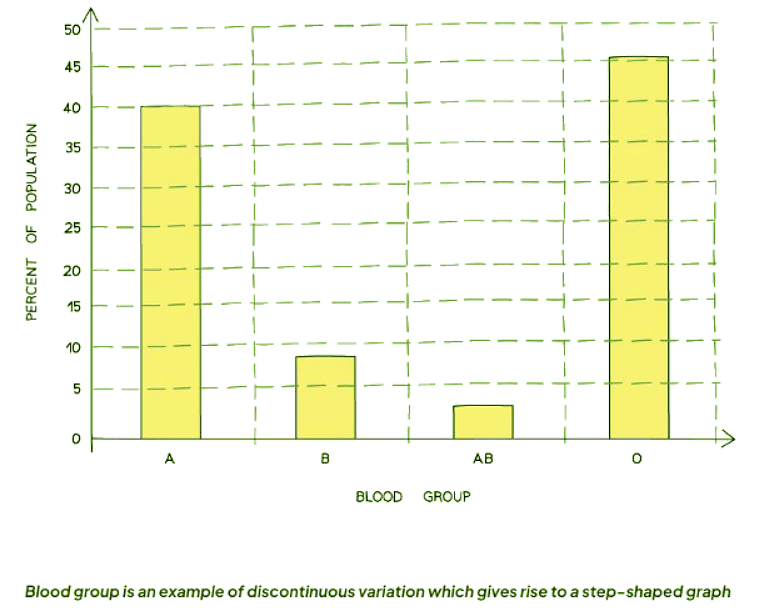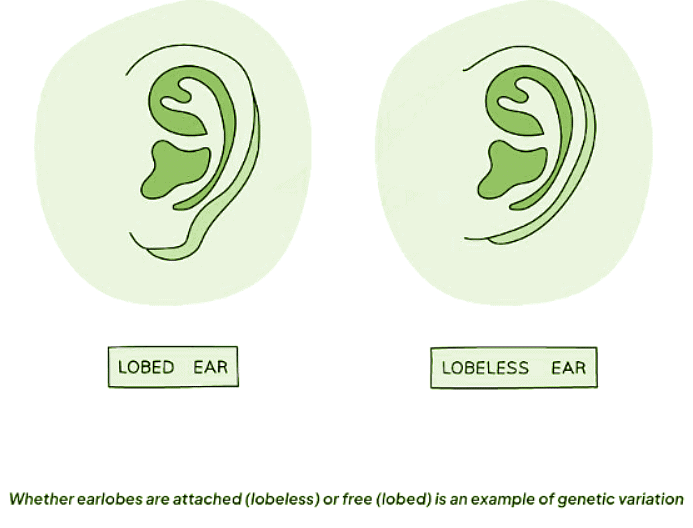Class 10 Exam > Class 10 Notes > Biology for GCSE/IGCSE > Variation in Biology
Variation in Biology | Biology for GCSE/IGCSE - Class 10 PDF Download
Types of Variation
What is Variation in Biology?
- Variation refers to differences among individuals of the same species.
- Phenotypic variation is the variation in features among individuals of the same species.
- Some of these differences are due to genetic differences, known as genetic variation.
- Phenotypic variation can be classified into two types based on measurement grouping:
- Continuous Variation:
- Characterized by many small degrees of difference for a particular trait.
- Differences can be measured on a scale and arranged in order.
- Examples include height, mass, and finger length with many intermediate groups.
- Discontinuous Variation:
- Characterized by distinct differences for a trait.
- Examples include blood groups (A, B, AB, O), sex (male or female), and tongue rolling ability.
- There are no intermediate states.
- Graphs of continuous variation produce smooth bell curves due to many small differences, while graphs of discontinuous variation show a "step-like" shape.


Phenotypic Variation
- Phenotypic variation can arise from two primary sources: genetic factors, which are entirely dictated by genes, and environmental factors, which are solely influenced by the organism's surroundings.
- Genetic variation is entirely controlled by genes, whereas environmental variation is a result of the organism's living conditions.
Genetic Variation
Genetic variation in humans encompasses diverse traits such as blood group, eye color, gender, the ability to roll the tongue, and the attachment of earlobes.
- Blood group
- Eye color
- Gender
- Ability to roll tongue
- Attachment of earlobes (whether attached or free)

Environmental Variation
- Characteristics of all living beings can be influenced by various external factors, including climate, diet, accidents, culture, and lifestyle.
- When we talk about the 'environmental' aspect, we refer to everything outside the organism, encompassing elements like climate, diet, culture, lifestyle, and life events.
- Examples of environmental influences:
- An accident may result in visible scarring on the body.
- Consuming excess food and leading a sedentary lifestyle can lead to weight gain.
- The country in which you are raised can determine the language you speak and the accent you have.
- A plant growing in the shade of a large tree will elongate to reach more sunlight for photosynthesis.
Genetic and Environmental Causes
- Discontinuous variation is typically caused solely by genetic variation.
- Continuous traits often vary due to a combination of genetic and environmental factors:
- Tall parents pass height-related genes to their children.
- Their children have the genetic potential to be tall.
- However, if the children have a poor diet, their growth may be stunted.
- Thus, the environment also influences their height.
- Essentially, while genes determine the characteristics we inherit, the environment affects how these inherited traits develop.
Mutation
- Mutations are changes in genetic material.
- Most mutations do not affect the phenotype because the mutated gene may produce a protein that functions similarly to the original.
- Rarely, mutations result in new alleles and phenotypes, typically having a minor impact on the organism.
- Occasionally, a new allele provides a survival advantage:
- For example, a mutation in a bird causes a change in feather color.
- This makes the bird more attractive to potential mates.
- As a result, the bird breeds more frequently, increasing the chances of passing the mutated phenotype to the next generation.
- Mutations can lead to harmful changes with significant effects on the organism, such as sickle cell anemia in humans.
- Mutations occur spontaneously and continuously, but their frequency can increase due to:
- Ionizing radiation (e.g., gamma rays and X-rays), which can damage bonds and alter base sequences.
- Some non-ionizing radiation (e.g., ultraviolet light), which can also damage bonds and alter base sequences.
- Certain chemicals, such as tar in tobacco.
- Increased mutation rates can cause cells to become cancerous, linking these factors to higher incidences of various cancers.
Question for Variation in BiologyTry yourself: What is the main difference between continuous and discontinuous variation?View Solution
Mutation: Extended
Genetic mutations can result from external agents like radiation and certain chemicals, leading to alterations in DNA that may trigger cancer development. It is crucial to limit exposure to these mutagenic factors to reduce the risk of genetic abnormalities.
Mutations and Their Effects
- Mutations refer to random changes in the DNA sequence
- These genetic alterations can impact the organism's traits
- Random Genetic Changes: Mutations are spontaneous modifications in the DNA structure.
- No Immediate Impact: Most mutations do not alter the organism's appearance as the mutated gene's protein can function similarly to the original gene's protein.
- Development of New Alleles: On rare occasions, mutations lead to the creation of new alleles and consequently new traits, typically with minimal effects on the organism.
- Survival Advantage: In some cases, a new allele can provide a survival benefit over others in the species.
- A specific example is when a bird undergoes a mutation resulting in a change in feather color, making it more appealing to potential mates.
- This attractiveness can lead to increased breeding opportunities, enhancing the chances of passing on the mutated trait to offspring.
- Harmful Effects: Mutations can also introduce harmful changes that profoundly impact the organism's well-being, such as sickle cell anemia in humans.
- These changes can cause severe health conditions and alter the organism's functionality.
- Factors Influencing Mutation Rates: Mutations occur spontaneously and persistently but can be accelerated by various factors, including ionizing radiation like gamma rays, x-rays, and ultraviolet rays, as well as certain chemicals like those found in tobacco.
- Ionizing Radiation:
- Gamma rays, x-rays, and ultraviolet rays are forms of ionizing radiation that can harm chemical bonds and alter DNA sequences.
- Exposure to certain substances like tar in tobacco can also lead to DNA damage.
- Effects on DNA:
- Increased mutation rates can result in cells becoming cancerous, explaining the higher incidence of various cancers associated with exposure to ionizing radiation and harmful chemicals.
Summary of Sources of Genetic Variation in Populations
- Mutations: New genetic variants arise from random alterations in DNA sequences.
- Meiosis: Genetic diversity is generated through the segregation and recombination of alleles during cell division.
- Random Mating: Different genetic partnerships are formed during sexual reproduction, contributing to genetic variation.
- Random Fertilization: Unique combinations of sperm and egg cells occur during sexual reproduction, further enhancing genetic diversity.
The document Variation in Biology | Biology for GCSE/IGCSE - Class 10 is a part of the Class 10 Course Biology for GCSE/IGCSE.
All you need of Class 10 at this link: Class 10
|
110 videos|210 docs|33 tests
|
FAQs on Variation in Biology - Biology for GCSE/IGCSE - Class 10
| 1. What is a mutation in biology? |  |
Ans. A mutation in biology refers to a change in the DNA sequence of an organism, which can result in genetic variation.
| 2. How do mutations occur? |  |
Ans. Mutations can occur spontaneously during DNA replication, exposure to mutagens such as chemicals or radiation, or as a result of errors in DNA repair processes.
| 3. What are the different types of mutations? |  |
Ans. The different types of mutations include point mutations (substitution, insertion, deletion), frameshift mutations, chromosomal mutations, and gene mutations.
| 4. How can mutations affect an organism? |  |
Ans. Mutations can have various effects on an organism, ranging from no noticeable changes to causing genetic disorders, changes in physical traits, or even leading to cancer.
| 5. Can mutations be beneficial? |  |
Ans. While most mutations are neutral or harmful, some mutations can be beneficial by providing organisms with new traits that increase their chances of survival and reproduction in a changing environment.
Related Searches















